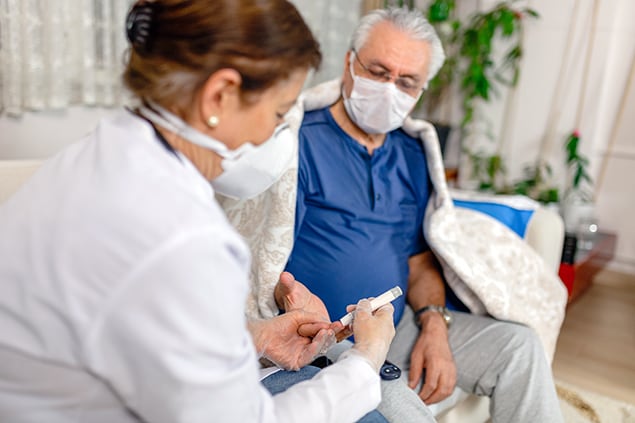Legal Epidemiology
What is legal epidemiology?
Legal epidemiology is the study of law as a factor in the cause, distribution, and prevention of disease and injury. It applies rigorous, scientific methods to translate complex legal language into data that can be used to evaluate how laws affect population health.
Legal epidemiology involves studying complex laws that address public health issues that can be used to quantitate data and be linked with health-related datasets. This method measures outcomes that policymakers can use to make decisions on issues that affect population health.
Read summaries of featured articles from the Journal of Public Health Management and Practice that explore the relationship between law and public health:
How is legal epidemiology connected to public health?
Law and public health are intricately linked, together shaping how people interact and experience the world around them. Laws can provide the foundation to help public health action occur. A growing body of evidence demonstrates legal epidemiology’s potential to drive change in the conditions where people live, work, and play.
Who uses and benefits from legal epidemiology?
Legal epidemiology is a field that unites public health lawyers, researchers, and practitioners toward a common pursuit to inform public health decision making that affects which laws work, for whom, and in what context.
Chronic and noncommunicable health conditions continue to drive morbidity and mortality in communities across the United States, posing a significant threat to our nation’s physical and economic health. Public health practitioners use legal epidemiology to examine the direct and indirect effects of law on populations at risk for chronic health conditions, thereby providing a powerful tool to gain insights and pursue more effective, equitable public health strategies.
The Journal of Public Health Management and Practice: Legal Epidemiology Supplement
The CDC’s Division for Heart Disease and Stroke Prevention (DHDSP), in collaboration with Temple University’s Center for Public Health Law Research (CPHLR), co-sponsored this special supplement, “Advancing Legal Epidemiologyexternal icon ” in the Journal of Public Health Management and Practice with the goal of informing the broader public health practice community about the field, its inherent principles, and its application to study and evaluate policies related to chronic disease.
The following articles explore the relationship between law and public health, specifically the ways in which law and policy affect population health outcomes linked to chronic and noncommunicable diseases. Each article includes a summary with an emphasis on how public health practitioners and policymakers can use legal epidemiology to recognize opportunities for achieving better health outcomes.
Featured Articles

Read a perspectiveexternal icon on how public health practitioners can use legal epidemiology to better understand how law acts as a social health determinant.
Editorial and Commentaries
Advancing Legal Epidemiology: An Introductionexternal icon
Thompson BL, Cloud LK, Gable L. Advancing legal epidemiology: an introduction. J Public Health Manag Pract. 2020;26:S1–S3.
The editorial highlights the use of legal epidemiology in public health practice and summarizes key messages from each of the nine research reports included in the “Advancing Legal Epidemiology” supplement.
The Growing Field of Legal Epidemiologyexternal icon
Burris S, Cloud LK, Penn M. The growing field of legal epidemiology. J Public Health Manag Pract. 2020;26:S4–S9.
The commentary describes the emergence of legal epidemiology, its key methods and tools, and the challenges the field faces moving forward.
Perspectives From the Field: Using Legal Epidemiology to Advance Public Health Practiceexternal icon
Benjamin GC. Perspectives from the field: using legal epidemiology to advance public health practice. J Public Health Manag Pract. 2020;26:S93–S95.
The commentary describes how public health practitioners can use legal epidemiology to better understand how law acts as a social health determinant. An improved understanding of this relationship can help public health practitioners maximize their efforts to improve chronic disease and noncommunicable disease prevention, especially when addressing a population’s access to health care, the built environment, and social supports.
Teaching the Future: Legal Epidemiology as a Model for Transdisciplinary Educationexternal icon
Gable L. Teaching the future: legal epidemiology as a model for transdisciplinary education. J Public Health Manag Pract. 2020;26:S96–S99.
The commentary discusses the need to incorporate and expand public health law into education programs and curricula. Public health students and practitioners can benefit greatly from understanding the role of law in improving health outcomes. Likewise, the author proposes that lawyers receive training and education on how evidence-based methods help to develop and put into action laws that can support better health outcomes.
Research Reports
Translating Workforce Development Policy Interventions for Community Health Workers: Application of a Policy Research Continuumexternal icon
Fulmer EB, Barbero C, Gilchrist S, et al. Translating workforce development policy interventions for community health workers: application of a policy research continuum. J Public Health Manag Pract. 2020;26:S10–S18.
The authors in this report apply a policy research continuum to examine community health worker (CHW) workforce development laws. The continuum includes examining early evidence, applying policy surveillance to identify national trends using evidence-based CHW laws, describing how to carry out the laws, as well as assessing the law effects on health and economic outcomes. When fully put into action, the policy research continuum will help public health practitioners make evidence-based health decisions.
Learn more about the policy continuum at Policy Resources on Heart Disease and Stroke Prevention.

Learn how stroke systems of care laws have the potential to improve timely access to care. Read the articleexternal icon.
Establishing a Baseline: Evidence-Supported State Laws to Advance Stroke Careexternal icon
Gilchrist S, Sloan AA, Bhuiya AR, et al. Establishing a baseline: evidence-supported state laws to advance stroke care. J Public Health Manag Pract. 2020;26:S19–S28.
This policy surveillance study examines both how stroke care delivery is regulated and legislated throughout the country and how state laws reflect the best available evidence shown to improve stroke outcomes. Stroke systems of care laws have the potential to improve timely access to care; however, no studies to date examine the effect these laws have on stroke-related population health outcomes. Although most states have enacted laws that address aspects of stroke care, the integration of the best available evidence into state law is unknown.
Mapping Housing Laws in the United States: A Resource for Evaluating Housing Policies’ Impacts on Healthexternal icon
Moran-McCabe K, Waimberg J, Ghorashi A. Mapping housing laws in the United States: a resource for evaluating housing policies’ impacts on health. J Public Health Manag Pract. 2020;26:S29–S36.
Researchers in this study sought to bridge gaps in knowledge by creating a data set to track the incidence and key features of state landlord-tenant laws, state fair housing laws, and city nuisance property ordinances. Safe, stable housing is key to good health, yet many Americans suffer from housing instability and poor-quality housing that limits their capacity to prevent disease and maintain health. The current state of housing in the United States prompts serious questions about the effectiveness of housing-related laws on population health.

Learn how insurance coverage can act as a barrier in accessing and delivering diabetes self-management education and training. Read the article. external icon
Advancing Diabetes-Related Equity Through Diabetes Self-Management Education and Training: Existing Coverage Requirements and Considerations for Increased Participationexternal icon
Carr D, Kappagoda M, Boseman L, Cloud LK, Croom B. Advancing diabetes-related equity through diabetes self-management education and training: existing coverage requirements and considerations for increased participation. J Public Health Manag Pract. 2020;26:S37–S44.
This article examines state insurance coverage laws to determine how diabetes self-management education/training (DSME/T) insurance coverage identifies potential gaps where coverage could be improved. DSME/T is a program shown to improve health outcomes and reduce health care costs in diabetes management; however, patient participation remains low. Researchers may assume that insurance coverage acts as a barrier in accessing and delivering DSME/T to patients.
Trends Over Time and Jurisdiction Variability in Supplemental Security Income and State Supplementary Payment Programs for Children with Disabilitiesexternal icon
Robinson LR, McCord RF, Cloud LK, Kaminski JW, Cook A, Amoroso J, et al. Trends over time and jurisdiction variability in Supplemental Security Income and State Supplementary Payment programs for children with disabilities. J Public Health Manag Pract. 2020;26:S45–S53.
This article describes the availability and amount of Supplemental Security Income (SSI) and State Supplementary Payment (SSP) program benefits, across jurisdictions and over time, to support families of children with disabilities. Legal epidemiology is an avenue to examine how SSP amounts vary across the nation that may be the first step to evaluating the National Academies of Sciences, Engineering, and Medicine’s proposed modification to SSI as a potential poverty alleviation and health improvement tool.1
State Preemption: Impacts on Advances in Tobacco Controlexternal icon
Kang JY, Kenemer B, Mahoney M, Tynan MA. State preemption: impacts on advances in tobacco control. J Public Health Manag Pract. 2020;26:S54–S61.
This study examines how tobacco legislation at the state level affects a local government’s ability to take public health action. Tobacco control policies are an effective way to reduce health harms linked to tobacco use. Some states, cities, and counties have adopted the strongest and most comprehensive policies to regulate tobacco use. State preemptive action can diminish the authority of local tobacco-control policies by superseding local officials’ power to regulate. The effects of preemptive state legislation on local tobacco-control policies are relatively unknown.

Learn how sodium reduction laws affect the health of people in the most populous cities and counties in the United States. Read the articleexternal icon.
Mapping and Analysis of US State and Urban Local Sodium Reduction Lawsexternal icon
Sloan AA, Keane T, Pettie JR, Bhuiya AR, Taylor LN, Bates M, et al. Mapping and analysis of US state and urban local sodium reduction laws. J Public Health Manag Pract. 2020;26:S62–S70.
The purpose of this study is to compile and analyze sodium reduction laws in the most populous cities and counties across the United States. Sodium reduction laws can improve public health and save money; however, consumers often lack the knowledge or access to lower-sodium choices in their food environment. State and local governments can issue sodium reduction regulations and legislation to address these concerns; however, little is known about the prevalence and effect these laws have in the United States.
Variations by Education Status in Relationships Between Alcohol/Pregnancy Policies and Birth Outcomes and Prenatal Care Utilization: A Legal Epidemiology Studyexternal icon
Roberts SC, Mericle AA, Subbaraman MS, Thomas S, Kerr W, Berglas NF. Variations by education status in relationships between alcohol/pregnancy policies and birth outcomes and prenatal care utilization: a legal epidemiology study. J Public Health Manag Pract. 2020;26:S71–S83.
This article examines how alcohol and pregnancy policies may have an effect on low birth weight (LBW), preterm birth (PTB), prenatal care use (PNC), and alcohol use during pregnancy. The study looks at pregnant women with varying education levels to assess the extent to which existing alcohol and pregnancy policies may impact their decision-making during pregnancy, and subsequently, lead to certain postpartum and infant health outcomes. Researchers hypothesize that women with higher education levels are more likely to experience better health benefits and fewer harmful behaviors when compared to their less educated counterparts, but this research has been relatively unexplored. The effect of these policies among women with different socioeconomic statuses is unknown.
Putting Policy Into Practice: School-Level Compliance With and Implementation of State Concussion Lawsexternal icon
Sullivan L, Harvey HH, Smith GA, Yang J. Putting policy into practice: school-level compliance with and implementation of state concussion laws. J Public Health Manag Pract. 2020;26:S84–S92.
This study assesses how 71 written high school concussion policies comply with their respective state concussion laws. Nationwide, concussions resulting from school athletic activities are addressed by state laws that aim to increase awareness and reduce its prevalence and severity in U.S. children 18 years and younger. Most state concussion laws include three core tenets: (1) immediate removal from play after an actual or suspected concussion; (2) medical clearance before an athlete can return to play (RTP); and (3) concussion education for athletes, parents, and coaches. However, concussion laws allow for a substantial degree of interpretation and discretion at the school level. Such variation can create inconsistencies in schools’ implementation and compliance with their respective state concussion law in their own policies.
Reference
- National Academies of Sciences, Engineering, and Medicine. A Roadmap to Reducing Child Povertyexternal icon. Washington, DC: The National Academies Press; 2019.
